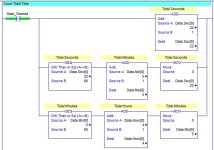Since CLX timer presets are of the DINT type, the maximum preset value would be 2,147,483,647.
Since CLX timers operate with a mS timebase, that means that the maximum number of hours that can be accumulated in a timer is 35,791. (2,147,483,647 / 1000 / 60)
You may want to consider a different method for accumulating run-time hours if you want to log more than 35,791 hours. Perhaps a periodic task that operates once per minute and adds 1 to an accumulator register whenever the motor is running, then divide the value of that accumulator register by 60 to convert from minutes to hours.
There are many methods for tracking run-time, and the choice depends upon the required accuracy and maximum number of hours you desire to keep track of.






